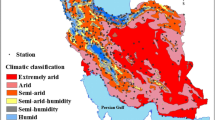Abstract
This paper deals with the most recent trends in meteorological and hydrological variables, which include air temperature and precipitation (P), potential and actual (ET) evapotranspiration, surface runoff (RO), water recharge into the soil (R) and water loss from the soil (L). Most hydrological variables were calculated via Palmer's algorithm. For this purpose, two rank-based statistical tests (the Mann–Kendall (MK) and a change-point analysis (CPA) approach) and the basic linear regression-based model were applied on the weekly precipitation and temperature from 17 stations all over Greece, during 1961–2006. Only in winter, all variables except for R, which showed no clear signal, presented downward trends. The declining trends of P and L in spring and summer were counterbalanced by reductions in RO (and R in the case of summer) as opposed to increases in ET. In autumn, the declining tendencies of P and L were offset by RO reductions and R increases. Annually, the trends in water cycle components were analogous to that of spring, summer and autumn. The number of stations with statistically significant (at 95%) trends greatly varied with season and meteorological/hydrological variable.



Similar content being viewed by others
References
Alcamo J, and 9 co-authors (2007) Climate change 2007: impacts, adaptation and vulnerability. In: Parry ML et al (eds) Contribution of working group II to the fourth assessment report of the Intergovernmental Panel of Climate Change. Cambridge University Press, Cambridge, pp 541–580
Balafoutis C, Arseni-Papadimitriou A (2003) Introduction in Hydrometeorology. Aristotle University Edition, p 30 (In Greek)
Feidas H, Makrogiannis T, Bora-Senta E (2004) Trend analysis of air temperature time series in Greece and their relationsip with circulation using surface and satellite data: 1950–2001. Theor Appl Climatol 79:185–208
Feidas H, Noulopoulou C, Makrogiannis T, Bora-Senta E (2007) Trend analysis of precipitation time series in Greece and their relationship with circulation using surface and satellite data: 1955–2001. Theor Appl Climatol 87:155–177
Goosens C, Berger A (1986) Annual and seasonal climatic variations over the Northern Hemisohere and Europe during the last century. Ann. Geophys B: 385–400
Jazim AA (2006) A monthly six-parameter water balance model and its application at arid and semiaridlow yielding catchments. Eng Sci 19:65–82
Kazakis N, Mavromatis T, Voudouris K (2008) Changes in extreme hydrological event frequencies in Greece. 9th Conference of meteorology, climatology and atmospheric physics, Thessaloniki, May 28–31, 2008, 887–894
Nastos PT, Zerefos CS (2008) Decadal changes in extreme daily precipitation in Greece. Adv Geosci 16:55–62
Nastos PT, Zerefos CS (2009) Spatial and temporal variability of consecutive dry and wet days in Greece. Atmos Res. doi:10.1016/j.atmosres.2009.03.009
Norrant C, Douguédroit A (2006) Monthly and daily precipitation trends in the Mediterranean. Theor Appl Climatol 83:89–106
Palmer WC (1965) Meteorological drought. U.S. Weather Bureau Research Paper 45. Available from NOAA Library and Information Services Division, Washington, DC, p 58
Papaioannou G, Mitropoulou A, Kitsara G, Kerkides (2009) Parameterization of potential evaporation and long-term water balance trends. EWRA 7th Interantional Conference on Water Resources Conservancy and Risk Reduction Under Climatic Uncertainty, Limassol, Cyprus, June 25–27, 2009, 37–44
Philandras CM, Nastos PT, Repapis CC (2008) Air temperature variability and trends over Greece. Global Nest J 8(2):273–285
Roderick ML, Rotstayn LD, Farquhar GD, Hobbins MT (2007) On the attribution of changing pan evaporation. Geophys Res Lett 34:L17403
Sibson R (1981) In: Barnett V (ed) A brief description of natural neighbour interpolation, interpreting multivariate data. Wiley, New York, pp 21–36
Sneyers R (1990) On the statistical analysis of series of observation. WMO Techn. Note No 143, Geneva, p 192
Stathis D, Mavromatis T (2009) Characteristics of precipitation in Thessaloniki area, north Greece. Fresenius Environ Bull 18(No 7):1–6
Tank AMG, and Coauthors (2002) Daily dataset of 20th-century surface air temperature and precipitation series for the European Climate Assessment. Int J Climatol 22:1441–1453
Taylor W (2000) Change-point analyzer 2.0 shareware program. Taylor Enterprises, Libertyville, Illinois. Accessed 2 July 2009. www.variation.com/cpa
Taylor W (2009) Change-Point Analysis: A powerful new tool for detecting changes. Accessed 2 July 2009. www.variation.com/anonftp/pub/changepoint.pdf
Thornthwaite CW (1948) An approach towards a rational classification of climate. Geogr Rev 38:55–94
Van Der Schrier G, Briffa KR, Jones PD, Osborn TJ (2006) Summer moisture variability across Europe. J Climate 19:2818–2834
Weber L, Nkemdirim L (1998) Palmer’s drought indices revisited. Geografika Annaler 80A:153–172
Wells N, Goddard S, Hayes MJ (2004) A self-calibrating Palmer Drought Severity index. J Climate 17:2335–2351
Xu CY, Singh VP (1998) A Review on monthly water balance models for water resources investigations. Water Resour Manag 12:31–50
Zaninović K, Gajić-Ćapka M (2000) Changes in components of the water balance in the Croatian lowlands. Theor Appl Climatol 65:111–117
Author information
Authors and Affiliations
Corresponding author
Rights and permissions
About this article
Cite this article
Mavromatis, T., Stathis, D. Response of the water balance in Greece to temperature and precipitation trends. Theor Appl Climatol 104, 13–24 (2011). https://doi.org/10.1007/s00704-010-0320-9
Received:
Accepted:
Published:
Issue Date:
DOI: https://doi.org/10.1007/s00704-010-0320-9




